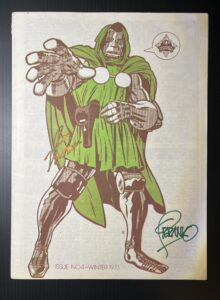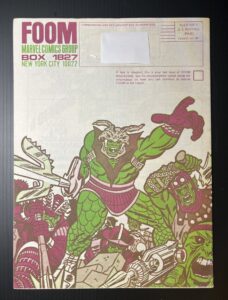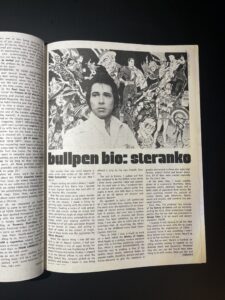F.O.O.M.: Friends Of Ol’ Marvel
In the 1970s, few comic book publications captured the spirit of the time quite like F.O.O.M., short for Friends of Ol’ Marvel. Launched in 1973, F.O.O.M. served as Marvel Comics’ official fan magazine, offering readers a unique blend of insider access, original content, and direct engagement with the Marvel Bullpen. Though it only ran for 22 issues across five years, the magazine remains a beloved piece of comic book history.
F.O.O.M. was born during a time when comic book fandom was becoming increasingly organized and enthusiastic. Marvel had previously experimented with fan clubs—like The Merry Marvel Marching Society in the 1960s—but F.O.O.M. marked a more ambitious and polished approach. Overseen initially by legendary artist and graphic designer Jim Steranko, with Marvel pioneer Roy Thomas as consulting editor, the first issue featured a striking wraparound Avengers cover and a bold, modern layout that stood apart from other fan publications of the day. Steranko’s influence on the early issues was obvious just by looking at the covers. His involvement set the tone for what F.O.O.M. would become: a dynamic blend of editorial content, character spotlights, fan-submitted art, and previews of upcoming Marvel stories. Even though Steranko left after issue #4, his influence persisted after his departure. Each issue offered fans a glimpse behind the scenes at Marvel’s creative process, with interviews of writers and artists, features on classic characters, and even sneak peeks at unreleased titles.
F.O.O.M. also became an important place for fans to communicate with each other. In a time before the internet, it was one of the few official channels where fans could interact with Marvel in print. Through letters, contests, and published fan art, readers found themselves woven into the Marvel narrative in a way that felt personal and participatory. In fact, issue #3 included a contest inviting readers to create their own original Marvel character. Among the hundreds of entries was a submission from future industry legend John Byrne, long before his memorable and influential runs on two of Marvel’s most popular books, X-Men and Fantastic Four.
I remember being aware of the magazine when I first started collecting in the mid-’70’s, but I couldn’t afford a subscription, so it wasn’t until many years later that I got my first issue: #4, with an understated but pretty awesome Dr. Doom cover. I’ve also included a few photos of interior articles, including one about Steranko himself.
Though the magazine experienced editorial shifts and irregular release schedules, it remained popular until its final issue in 1978. Changing market trends, along with Marvel’s growing focus on licensing and merchandise, eventually led to F.O.O.M.’s quiet cancellation. It would eventually be replaced by Marvel Age in 1983, but it just wasn’t the same. That was a comic book, not a magazine, and it lacked the cool 1970’s, more personal vibe.
Despite its relatively short run, the impact of F.O.O.M. can still be felt 50 years later. It really was at the start of organized fan culture on a national scale, without which there couldn’t have been the current environment with millions of fans worldwide connected by the internet and their love for the medium. In fact, in 2017 Marvel revived the F.O.O.M. name for a special-edition magazine released at San Diego Comic-Con, acknowledging the publication’s place in Marvel history.
F.O.O.M. wasn’t just a fan magazine—it was a time capsule of one of Marvel’s most creative eras. For many readers, it was the first real invitation to become part of the Marvel Universe.
Jeff Mara





